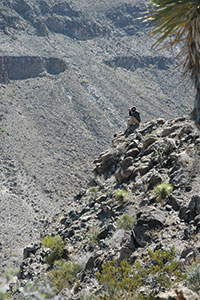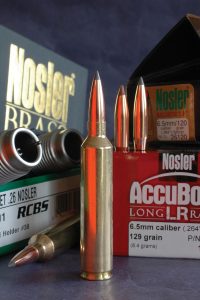The first predator I recall shooting was a hapless red fox. I was not hunting foxes, but deer. The Michigan wood was thick with new snow, the fox a russet blur as it darted from behind a deadfall. I fired as if at a grouse, rolling the animal with my iron-sighted .303 SMLE at 12 steps.
Many years later, I bellied onto Wyoming prairie with an accurate Remington 700 and settled the crosswire just windward of a coyote, mousing 330 yards off. A long poke. The quick bullet landed well.
These days, tales of long shooting and claims about hardware with township-wide reach suggest that hunting has become assassination, that the only useful measure of a load is bullet trajectory. Hence, the recent proliferation of so-called long-range bullets.
Actually, most bullets can travel far. One that has a great reach is the 500-grain round-nose from the .458 Winchester Magnum, which is counter-intuitive if you believe bullets deadly at distance have long, pointed noses and tapered heels (boat-tails).
As you needn’t brook the gum-numbing, clavicle-shattering recoil of a .458 to pester coyotes and fox, fast smallbore bullets make more sense. In my youth, the .222 was a favorite of pelt-hunters in the Pennsylvania hills and Midwest croplands. The .22-250 and .220 Swift got greater play in the West. The middle 1950s brought us the .243 and .244 (6mm Remington); a decade later, Remington adopted the fast-stepping .25-06. While some riflemen dote on .17s for predators, the hot .22s, .24s and .25s have yet to be upstaged. But bullets have improved, and I’m increasingly forced to smile weakly at cellphone images of coyotes felled by exceedingly powerful cartridges because they feature long-range bullets.
Whoa. Can’t you make long, rocket-shaped bullets in small diameters? Well, yes, you can. But the bullet’s ballistic coefficient (or C — simplistically, a number representing the ability of a bullet to overcome drag) includes weight and sectional density as well as form. That’s why a bluff-nose 500-grain .458 bullet may boast a C of .400, while a 50-grain .224 bullet you can drive at 3,800 fps has a C of only .200. A .22 or 6mm bullet to match C values of most 6.5mm and 7mm bullets would be very long, consuming powder space or bumping against magazines while increasing bore friction and thus limiting speed. The longest would require sharper, non-standard rifling twist.
Probing deeper into the weeds, we find G1 and G7 C values. Cleanly put, C is a relative measure against a “standard bullet.” The G1 standard resembles a 19th-century artillery round. The G7 more nearly simulates sleek, modern target and hunting bullets. Most manufacturers print G1values, perhaps because they’re twice as high as G7 values.
C doesn’t define drag, but the higher the C, the better the bullet fights drag. The result is a lower rate of deceleration, flatter flight and better wind-bucking ability. C is commonly determined by measuring velocity at two or three points 100 yards apart on a bullet’s path then calculating flight time between them. Alas, such deceleration results don’t always show what to expect of the bullet — espe cially at higher velocities.
cially at higher velocities.
A couple of years ago, ballisticians at Hornady noticed a disparity between predicted flight paths and downrange velocities, and those actually recorded. The only plausible explanation was also unlikely: bullet shape was changing in flight! Dave Emary, with Joe Thielen, Jayden Quinlan and Ryan Dammar, figured the only way to find out was to employ Doppler radar, which serves weather forecasters and the highway patrol at speed traps. Doppler units vary widely in capability; none are cheap. Hornady bought a mid-level unit the size of an oven door. Like a laser rangefinder, it sends a beam (from the top half) then receives and reads a return beam (bottom half). “Instead of recording bullet speed every 100 yards,” says Dave, “the Doppler unit tells us the speed and position of a bullet every 2 feet. We get a boatload of data that accurately shows the actual C and arc.”
The Doppler confirmed a change in C, which the Hornady team quickly attributed to melting of polymer bullet tips. Jayden Quinlan hastens to say this isn’t a universal problem. “Some bullets don’t fly fast enough to reach the 800-degree melt temperature of the polymer. Others, like .22s from the Swift, exit at lightning speed but decelerate quickly, given their modest C values. Still others just don’t spend enough time in the air to suffer tip deformation, regardless of their shape or launch speed.” Joe tells me that changes in C appear on Doppler radar only well beyond the 300-yard mark. “In rough terms, we see tip melt in bullets of at least .550 starting C, launched at magnum (3,000 fps) velocities over distance.”
Now, poly-tipped bullets, while popular, aren’t the only type used for long shooting. Sierra and Berger hollowpoints and Hornady’s BTHP Match have a great record on bull’s eyes. Open hollowpoints in smallbore cartridges can also have explosive effect on small animals. “But hollowpoints aren’t as uniform at the nose,” says Ryan Dammar. “Forming the jacket leaves tiny irregularities up front. Each polymer tip is just like the next. Uniformity means accuracy.”
Incidentally, poly-tip bullets aren’t just hollowpoints with a cap. The core and tip are designed to work together. After the core is exposed during penetration, the material and disposition of the tip — less than 1 percent of the bullet’s weight — matter not. Hornady ballisticians denounce the use of match bullets for big game and question their use on smaller animals. “Terminal performance of OTM (open-tip match) bullets doesn’t impress us,” says Jayden. “We see curved bullet tracks in gelatin, unreliable penetration and upset. Tips can collapse inward, yielding no expansion. Or they can shear, causing the shank to tumble.”
While tip-melt won’t happen to most bullets in most hunting situations, it can become a factor as hunters turn to long bullets in big cases and dial 20X scopes to lob bullets across zip codes. So Hornady’s team sought a new polymer. The result is the Heat Shield Tip.
The Heat Shield Tip’s patented material has a glass transition temperature of 475 degrees, eight times as high as that of nylon and Delrin tips. Its melt temperature of 700 degrees is twice as high, close enough to the 800-degree worst-case ceiling as to render any tip melt negligible. Hornady paired the new polymer with a fresh core-and-jacket design to come up with the ELD-X (Extremely Low Drag, Expanding) bullet.
The ELD-X tip is darker and more translucent than Hornady’s SST bullet tip. It’s a bit larger too, with a bigger shank. It’s fitted to a lead-core bullet in a nose cavity coned at the bottom. The tapered, heavy-base jacket has an Interlock cannelure high on the shank to protect more of the heel than do Hornady’s Interlock bullets. Jacket taper at the nose and a generous cavity at the jacket mouth, trigger upset down to 1,600 fps, controlled expansion to 2,900.
Hornady offers ELD-X bullets in loaded ammo with a new Precision Hunter label. “We’re using temperature-insensitive, single-base powders,” says Dave Emary. “Velocities match those of our Custom line, not Superformance loads.” Two bullets, a 175-grain 7mm and a 212-grain .30 are for handloading only, as they’re very long. “We’ve no plans to make ELD-X bullets in diameters below 6.5mm. There is no practical advantage to the Heat Shield Tip until G1 C values exceed .550.”
You’ll need an accurate rifle to assess the ELD-X — and ELD-Match bullets on the horizon at this writing. Other bullets from Nosler, Berger and Sierra, and an increasing number developed in-house by Winchester, Federal and other ammunition firms, are nudging C values ever higher. All else equal, ELD-X bullets may print smaller groups with less vertical stringing. Hornady claims half-minute accuracy. My friend Greg Sweney, who builds super-accurate bench rifles, printed a .213 group with ELD-Xs in a .26 Nosler sporter on a BAT action. Expect no measurable bonus from these bullets at modest ranges.
Ammunition with ELD-X bullets and their Heat Shield tips are selling for about the same price as Superformance with SST bullets. Handloaders can buy boxes of 100 bullets at lower prices than listed for competitive bullets from Barnes, Nosler and Berger.
I’ve not used ELD-X bullets on fox at 12 steps or coyotes at 300. But my extensive shooting at steel plates to 1,200 yards show these bullets have a bright future. I’ve also seen their effects in gelatin. At 150-yard velocities, the 200-grain .30 caliber carved huge, uniform temporal cavities from 2 to 11 inches along 23-inch bullet tracks. At 800-yard speeds, the gelatin suffered less, but temporal cavities were nearly the same length behind straight penetration to 24 inches. Bullets from competitors didn’t fare quite as well. A hollowpoint at 150-yard speed blew a wide cavity from 5 to 13 inches, but stopped at 16. Another poked a longer but scimitar path. At 800-yard speeds, two off-brand bullets strayed off course.
In sum, shooting predators at 300, even 400 yards, you’re well served by sleek, mid-weight .22, .24 and .25 bullets — soft-nosed, poly-tip or large-cavity hollowpoints. At extreme range, larger spitzers (6.5 and 7mm) can hike your odds of hitting. In wind, you’ll get an even bigger boost.
A 180-grain .303 bluff-nose softpoint is hardly an ideal predator bullet. It rolled that fox long ago because, like most predators shot by hunters, the animal was close. A hollowpoint from a .22 WMR might have done the same. But when distance tests your marksmanship and your optics, a long-range bullet like the ELD-X can deliver what other bullets don’t. A pelt, for instance.






